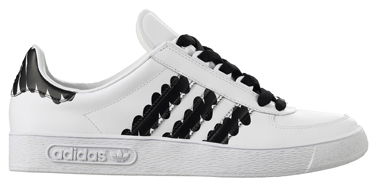In Living Color

Above: Claude Closky’s design for Adidas’s new “Adicolor” line.
The D.I.Y. movement has gathered steam and gone mainstream. In recent months, companies as different as Hewlitt Packard and L.L. Bean have encouraged their customers to customize, and nowhere has this trend been more prevalent than in the all-important sneaker market. Nike’s “iD,” launched online and through brick-and-mortar, was followed by a similar effort from Vans, who tossed in a few models by celebrity fashion designers for those with artist’s block. Converse soon followed suit, asking sneaker fashionistas to “unleash their inner control freak” on their classic Chuck Taylors, and now Adidas has joined the mix with their “Adicolor” line.
The mechanics of Adidas’s “Adicolor” line blends many of the lessons of those D.I.Y. lines that preceded it, along with a dash of the company’s history. Like Nike’s iD, the color palatte is purposefully limited: red, white, blue, yellow, green, pink, and black are your choices. Like Vans, they have asked fashion designers to contribute a few prepackaged ideas: Claude Closky’s design for the trendy Paris store Colette is a particular favorite of the Doctors. And Adidas has even encouraged a healthy amount of cross-promotion, tapping cultural icons like the Muppets, Keith Haring’s faceless cartoons, and even Betty Boop to share the stage with the triple stripes.
But the company also has the cojones to suggest that – even though they may be last to the party – the whole custom-shoe idea originated with them in 1983, when the eponymous Adicolor line was launched at the Ipso Fair in Munich. There, Adidas made blank white sneakers and packaged them with quick-drying waterproof markers. Budding Picassos were left to do the rest.
Sneakers brands have always inspired fierce loyalty in their customers, and even people who are rarely seen wearing a single oversized logo will proudly sport the Nike Swoosh, the New Balance N, or the Adidas triple-stripe on their feet. People brand themselves with their sneaker associations. Nike attracts basketball fanatics through their iconic Air Jordans and serious athletes through their futuristic Air Maxes and Air Prestos. Adidas attracts a similar kind of fanaticism about soccer with its Samoas and a retro preppy style with its Rod Lavers and Stan Smiths. New Balance’s ugly-cool sneakers have a geeky liberal chic, and the brand is all about running, as if its loyal followers do a marathon here and a protest there without stopping to retie their kicks.
Sneaker brands have the added advantage of tapping into the whole psychology of shoes. Feet are fetish body parts for many, and shoes have long been symbols of wealth and good breeding. For urbanites, the main form of transportation is by foot, so shoes are their S.U.V.s. Sneakers are literally walking logos. Added to this are all of our metaphorical associations with “standing” for something or a “platform” for our beliefs: our shoes are literally involved in these actions.
Sneaker brands have taught buyers their own platforms well. So well, in fact, that it’s time to let buyers riff on these messages a bit. In the arena of emotional messages, we learn first by empathy and then by application. We, the sneaker-buying public, have been taught well. Wisely, the sneaker companies have now decided to let us play.